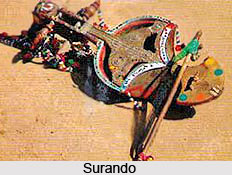 Surando is an ancient folk musical instrument of Kutch. It is also common to Sindh, Baluchistan and Frontier regions. Derived from the Persian word "surayindah" which means "the producer of tunes", it is called Saro in the Baluchistan region and Sarindah in the Frontier region. Surando known in Kutch is believed to have been well known as Sarinda in northern parts of India and in Sindh of Pakistan. It is a stringed musical instrument played with the use of Bow, Gaz or Gazi in local dialect.
Surando is an ancient folk musical instrument of Kutch. It is also common to Sindh, Baluchistan and Frontier regions. Derived from the Persian word "surayindah" which means "the producer of tunes", it is called Saro in the Baluchistan region and Sarindah in the Frontier region. Surando known in Kutch is believed to have been well known as Sarinda in northern parts of India and in Sindh of Pakistan. It is a stringed musical instrument played with the use of Bow, Gaz or Gazi in local dialect.
Structure of a Surando
The body of the instrument is made of all sorts of wood, but to serve as an excellent sound chamber Lahirro wood is the best one. Talhi, Bahan and Mango wood rank second, third and forth in importance. The Bow or Gaz is comprised of strings of horse`s hair or gut fastened to each of a flexible stick. A Surando has six strings - five of steel and the sixth of copper and each strings has specific name like Agor, Tip, Jara etc. The more developed type has 8 to 9 strings and is more common. Some players use the 11 to 13 strings Surando as well. All the strings are made of steel except the Saggo, which is the second string from the left. It is referred to as "the queen string" and is the key string which is made out of gut.
How to Play a Surando
The Bow is placed on the strings at right angles to it and is moved back and forth across it. Producing sound with the help of the bow in friction with the strings is a more advanced skill than plucking. Strings are tuned to a proper frequency by tuning the pegs on the instruments. Surando is played like Sarangi and it is similar to Sarangi and Violin.
Incident on Surando
A famous incident to support this is the incident of Kanghar, the Samma Chief who was the ruler of Junagadh. An accomplished bard, Bijal by playing the Surando music had such an influence on him that when he asked for the king"s head as a reward, Kanghar sacrificed his life to pay homage to the high art.
Since long, the Surando has been played by charans, mangatas and manganhars which are different professional Sindhi bards. When handled by master musicians, the Surando has a devastating effect. Wandering minstrels go around playing the music and use the appeal of the Surando music to test people"s magnanimity and munificence. Surando is prepared artistically getting intricate carving from the single piece of teak wood. It is given a pea-cock shape. To get decorative impression of Surando, the tiny nails of brass can be fixed on its surface. It is also painted with colors prepared from mercury or zinc for attractive show.
Renowned Surando musicians include Bijal, Ali Muhammad Langho, Achar Faqir and Khan Macchi.




















